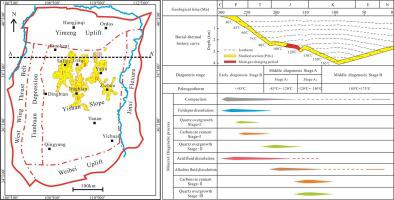当前位置:
X-MOL 学术
›
J. Asian Earth Sci.
›
论文详情
Our official English website, www.x-mol.net, welcomes your
feedback! (Note: you will need to create a separate account there.)
Diagenetic evolution and densification mechanism of the Upper Paleozoic tight sandstones in the Ordos Basin, Northern China
Journal of Asian Earth Sciences ( IF 2.7 ) Pub Date : 2021-01-01 , DOI: 10.1016/j.jseaes.2020.104613 Nina Su , Fan Song , Longwei Qiu , Wei Zhang
Journal of Asian Earth Sciences ( IF 2.7 ) Pub Date : 2021-01-01 , DOI: 10.1016/j.jseaes.2020.104613 Nina Su , Fan Song , Longwei Qiu , Wei Zhang

|
Abstract The Upper Paleozoic sedimentary succession in the Ordos Basin, Norther China, contains typical tight gas sandstones. Densification process and diagenetic evolution of these sandstones are poorly known but are important for exploration of reservoirs. Herein, petrographic features of these rocks are described by using scanning electron microscopy (SEM) and cathodeluminescence. In addition, inclusions in quartz overgrowth and calcite cementation are examined with homogenization temperature measurements, and Raman spectroscopy. The sandstones are mainly quartz sandstone, lithic quartz sandstone and lithic sandstone, with a medium to coarse grain size and good sorting. The reservoir properties are quite poor, with low porosity and permeability. Densification of the Upper Paleozoic sandstones are attributed to long-term mechanical compaction and multi-stages of siliceous and calcite cementations. Moreover, the quartz dissolution due to the presence of alkaline fluid forms intragranular and intergranular pores, thus providing the main space for the sandstone reservoirs. During the diagenetic evolution, tight sandstone reservoirs have experienced various stages of rapid burial and strong compaction, alternate acidic and alkaline actions, formation of reservoirs, uplifting and rework, with great differences between these stages in mineral assemblage and reservoir physical property. Massive hydrocarbons were generated following Stage Ⅱ of quartz overgrowth in which the number of quartz dissolved pores substantially increased because of more intensive alkaline dissolution. The hydrocarbons preferably flow into the reservoir strata with better properties, thus forming tight sandstone gas reservoirs.
中文翻译:

鄂尔多斯盆地上古生界致密砂岩成岩演化及致密化机制
摘要 鄂尔多斯盆地上古生界沉积层序为典型的致密气砂岩。这些砂岩的致密化过程和成岩演化知之甚少,但对储层勘探很重要。在此,通过使用扫描电子显微镜 (SEM) 和阴极发光来描述这些岩石的岩相特征。此外,石英过度生长和方解石胶结中的包裹体通过均质化温度测量和拉曼光谱进行了检查。砂岩以石英砂岩、岩屑石英砂岩和岩屑砂岩为主,粒度中粗,分选性好。储层物性较差,孔隙度和渗透率较低。上古生界砂岩的致密化是由于长期的机械压实作用和多阶段的硅质和方解石胶结作用。此外,由于碱性流体的存在,石英溶解形成粒内和粒间孔隙,从而为砂岩储层提供主要空间。致密砂岩储层在成岩演化过程中,经历了快速埋藏、强压实、酸碱交替作用、成藏、抬升改造等各个阶段,其矿物组合和储层物性差异较大。在石英过度生长的第二阶段之后产生了大量的烃,其中由于更强烈的碱性溶解,石英溶解孔的数量显着增加。
更新日期:2021-01-01
中文翻译:

鄂尔多斯盆地上古生界致密砂岩成岩演化及致密化机制
摘要 鄂尔多斯盆地上古生界沉积层序为典型的致密气砂岩。这些砂岩的致密化过程和成岩演化知之甚少,但对储层勘探很重要。在此,通过使用扫描电子显微镜 (SEM) 和阴极发光来描述这些岩石的岩相特征。此外,石英过度生长和方解石胶结中的包裹体通过均质化温度测量和拉曼光谱进行了检查。砂岩以石英砂岩、岩屑石英砂岩和岩屑砂岩为主,粒度中粗,分选性好。储层物性较差,孔隙度和渗透率较低。上古生界砂岩的致密化是由于长期的机械压实作用和多阶段的硅质和方解石胶结作用。此外,由于碱性流体的存在,石英溶解形成粒内和粒间孔隙,从而为砂岩储层提供主要空间。致密砂岩储层在成岩演化过程中,经历了快速埋藏、强压实、酸碱交替作用、成藏、抬升改造等各个阶段,其矿物组合和储层物性差异较大。在石英过度生长的第二阶段之后产生了大量的烃,其中由于更强烈的碱性溶解,石英溶解孔的数量显着增加。











































 京公网安备 11010802027423号
京公网安备 11010802027423号